
A map of Cyrodiil.
- For this province in The Elder Scrolls Online, see Cyrodiil (Online).
- "It's our natural barriers that keep us safe, mostly. Mountain borders north and east, open sea to the west, and bogs and rainforest to south."
- ―Adamus Phillida[src]
Cyrodiil, also known as Cyrod[1] or the Imperial Province for much of its history,[2][3] has been the capital province of three human empires in Tamriel, and is the homeland of the Imperials, as well as Minotaurs.[2]
It is situated in the center of Tamriel, and has had a varied climate throughout its history.[4][5] Cyrodiil is a wealthy and powerful nation and is the center of the Empire. Cyrodiil serves as the setting for The Elder Scrolls IV: Oblivion. The demonym is "Cyrodilic."
People[]
Imperials[]

Artwork of an Imperial from The Elder Scrolls: Legends.
- Main article: Imperial
Also known by the demonym "Cyrodiils,"[6] the natives of Cyrodiil that comprise the "Imperials" are divided into two ethno-cultural groups; the Nibenese and Colovians. Colovian Imperials in Western Cyrodiil have a less complicated outlook, and are more self-reliant and independent.[2] Nibeneans are closer in heritage to pure Nedes than Colovians,[7] and are generally more concerned with aesthetic and spiritual pursuits than their western brethren. Both groups reflect the Empire's culture; a hybrid of Nordic, Aldmeri, and Akaviri culture. When there is a schism within the Imperial province, it tends to divide along Colovian-Nibenese lines.[2]
Ayleids[]
- Main article: Ayleid
Ayleids, also known as Wild Elves or Heartland High Elves,[8] were a group of Aldmer who immigrated to the province in the Merethic Era. Ayleids worshiped both Aedric and Daedric deities, and forced the Nedes in slavery.[9] The Ayleids had many cities scattered across Cyrodiil, all now turned to ruin. In 1E 242, the Nedic slave queen Alessia led a rebellion which overthrew the Ayleids.[10] Following this, many Ayleids fled to neighboring provinces, most notably Valenwood.[11] By the end of the First Era, most Ayleids were extinct, and the last Ayleid died in 2E 582.[12]
Nedes[]
Records of a Nedic civilization during the Merethic Era exist.[13] However Ayleids had started to migrate to Cyrodiil, where they enslaved them into their service.[14][9]
Minotaurs[]
- Main article: Minotaurs
Minotaurs are a race of beastfolk to reside in Cyrodiil,[15] and are identified as having the body of a Man and the head of a bull.[UL 1] By the Third Era, Minotaurs are said to not be particularly intelligent, and are described as "cruel Man-eaters."[UL 1]
Bird Men[]
- Main article: Bird Men
Topal the Pilot was said to have found an extraordinary race of "bird creatures" inhabiting what is now the City Isle in the Merethic Era. They could not be saved from the hands of the "cat demons," believed to be ancient Khajiit.[16]
Government[]
Central government[]

The Elder Council functions as the primary legislative authority of the Third Empire of Tamriel.[17] The Council convenes at its chambers in the White-Gold Tower, in the Imperial City.[18] The Council passes a variety of legislation, and has the power to levy taxes from Imperial provinces.[19] The Emperor possesses a veto power over any legislation passed by the Council.[17]
Appointed by the Emperor, the Council is typically made up of the wealthiest and most powerful men in the Empire.[20] In times where the succession of the Empire is disputed, the Elder Council has both ruled as an interim government and confirmed the final choice of successor. This state of affairs has persisted between the various Cyrodilic empires.[21][22][23]
Local government[]
Each major city has its own Count or Countess who rules over the city, and the surrounding county.[24] The Imperial City doesn't have a Count as it is ruled directly by the Emperor.
Military[]
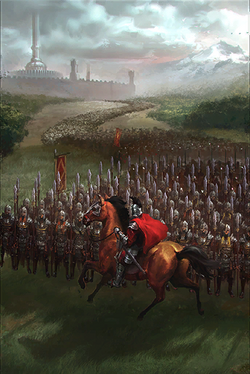
Soldiers of the Imperial Legion.
As the Imperial Province, the region has unrivaled access to the Imperial Legion. The force itself comprises several Legions,[25] and is the main fighting force in Cyrodiil and the Empire. Although the majority of the Legion's soldiers come from western Cyrodiil, the Legion is composed of many races from throughout the empire.[2][26][27] The Legion's tactics and organization come, to a large degree, from Akaviri practices learned from slaves captured after the Akaviri invasion in the First Era.[2] Its headquarters is located in the Imperial City's Prison District.[28]
Most of the Legion wears armor that is a combination of leather and chain mail, resembling Roman auxiliary armor called Imperial Light Armor. The Legion Legates, however, wear Imperial Armor which largely resemble Roman Lorica Segmentata armor or Roman Legionnaire armor. These show the status of each soldier. Imperial legionnaires are trained in a variety of weapons, from polearms to all forms of blades, as well as having specialized cavalry, archers and healers.[29] Imperial battlemages form a specialized corps within the Legion.[25]
History[]
Merethic Era[]
The earliest accounts of Cyrodiil is the ballad of Topal the Pilot in the Middle Merethic Era, an Aldmer explorer who navigated much of Tamriel. The ballad mentions a range of creatures in the Nibenay valley, mostly birds and beasts.[16] There are records of Nedic civilization in Cyrodiil during a similar period, however.[30] This was apparently quite advanced, with a series of ruined cities containing catacombs built within mountains and other advanced structures.[31]
During this time the Ayleids migrated to Cyrodiil, enslaving the Nedes in the service of their empire.[32][9]
First Era[]
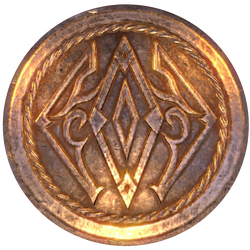
The Emblem of the Alessian Empire.
In 1E 242, during a period of civil strife between the Ayleid lords,[10] Alessia received a vision from Akatosh at Sancre Tor and began a revolt against Ayleid rule.[6][33] The Amulet of Kings was forged at this time, as a sign of the pact between them and a reminder that Akatosh would "hold fast the gates of Oblivion," limiting Daedric access to Mundus and thereby assisting Alessia's rebellion.[34] She was joined her revolt by the heroes Pelinal Whitestrake and Morihaus.[35] This rebellion overthrew the Ayleids in less than two years,[10] aided by Nords and uniting the Colovian and Nibenese peoples into one, the empire of Cyrodiil.[36][6] There also appears to be some revenant of the Ayleids holding land under Alessian rule for some years after the initial rebellion.[10] Due to this patchwork of different cultures and beliefs, most particularly Alessia's Nord allies and the culturally merish slaves she had liberated, Alessia created the pantheon of the Eight Divines at this time as a compromise between merish and Nordic beliefs.[36]
In an alliance with Skyrim, the Alessian Empire pushed far west towards High Rock, which, at the time, was under the control of the Direnni, a clan of Altmer.[6] This expansion, taking place in the centuries following the rebellion, also saw the rise of the Alessian Order, a monotheistic organization led by the prophet Marukh.[6] These doctrines held sway over Cyrodiil for many centuries, and during this time a particularly fanatical sect, known as the Marukhati Selective, attempted to purge the merish elements from Akatosh.[37] This resulted in the 1,008 year Dragon Break known as the Middle Dawn.[38] Ultimately, the Alessian Order and the empire it supported fell to the War of Righteousness within ten years.[2]
In 1E 2703 the Akaviri invaded Tamriel.[39] The Akaviri were defeated at the Battle of Pale Pass by Reman Cyrodiil, where the Tsaesci swore loyalty to him and became the dragonguard, forerunners to the Blades.[40] Also from this point on until the end of the First Era, Tsaesci would serve in the Imperial government, most noticeably as the Akaviri Potentate. Under the new rule of Emperor Reman I, Cyrodiil became cosmopolitan, and incorporated architectural and geometrical aspects of High Rock, Colovian, Nibenese, and even Akaviri culture.[2]
The Reman dynasty ruled Cyrodiil for more than 200 years after the Akaviri invasion, and under Reman II brought all of Tamriel save for Black Marsh and Morrowind into the Empire.[41] Reman II also began the inconclusive Four-Score War with Morrowind, which ended in a truce after with the death of Reman III.[42]
Second Era[]
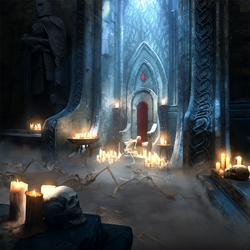
The empty Ruby Throne during the Interregnum.
Although the Reman Dynasty ended in the First Era, the Second Empire endured under the control of Akaviri Potentates. This period saw the outlawing of private armies, and the creation of the Fighters Guild from the Akaviri Syffim in 2E 321 as the weakening Potentate attempted to maintain its power.[43][44] Savirien-Chorak, last Potentate, was killed by the Dark Brotherhood in the year 2E 430.[45]
Throughout the rest of the Second Era, Tamriel was in a state of chaos known as the Interregnum which lasted four hundred years.[46] Nibenay and Colovia split apart, and much Imperial infrastructure fell into disrepair.[6] Many petty warlords tried to claim the Imperial throne.[20] A warlord known as Cuhlecain arose and, with the help of Talos, his general, reclaimed much of the First Empire's territories.[2] Following the Battle of Sancre Tor, which saw many Nords join Culecain's cause,[47] he was assassinated, either by Talos or an unknown Breton assassin.[2][48] Talos subsequently took the name Tiber Septim and was crowned Emperor by Zurin Arctus.[2][48] In doing so, he declared the first year of his rule to the be the first of the Third Era.[20]
Third Era[]
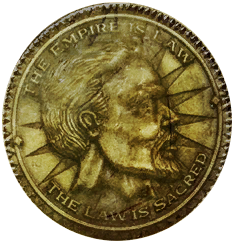
A Septim; a coin used as the currency of the Septim Empire depicting Tiber Septim.
After his coronation, Tiber Septim embarked on a period of restoration for Cyrodiil, in addition to solidifying the provinces of High Rock, Skyrim and Hammerfell under his rule for the first twenty years of his reign.[2] He died in 3E 38, and was succeeded by his grandson, Pelagius I.[20]
A succession of emperors and empresses followed, with Potema of Solitude attempting to claim the Ruby Throne for her son Uriel, beginning the War of the Red Diamond in 3E 120.[49] The Imperial City was invaded by Uriel in 3E 121 as part of the initial attack, resulting in the seizure of the city and his coronation as emperor.[50] The tide was turned when Cephorus, another claimant to the throne, agreed to loosen centralised control over certain provinces in exchange for their support against Potema.[51] Although some consider the war to have been over by 3E 127, Potema held out for a further ten years, supported by undead and Daedric minions, before dying during a siege of her castle.[52]
A variety of crises in the following years continued to weaken the authority of the Empire, although only some of these touched the Imperial Province itself. The Imperial Battlemage Jagar Tharn imprisoned the Emperor Uriel Septim VII in 3E 389. The time of the Imperial Simulacrum that followed resulted in a general decline in relations between Cyrodiil and its provinces, as Tharn's mismanagement caused provincial authorities to rise up against the Empire.[53]
In 3E 433, Uriel Septim VII was assassinated by the Mythic Dawn cult, precipitating the Oblivion Crisis whereby Mehrunes Dagon attempted to invade Tamriel. Martin Septim and the Hero of Kvatch stopped this, by destroying the Amulet of Kings and defeating Dagon on the streets of the Imperial City itself.[54] Following the Crisis, Chancellor Ocato, acting as Potentate, declared the end of the Third Era.[55][56]
Fourth Era[]

Emperor Titus Mede II.
After the death of Potentate Ocato in 4E 10, the Stormcrown Interregnum began, which saw a series of pretenders attempt to claim the throne of Tamriel.[57] The Mede dynasty rose to power in 4E 17 when Titus Mede I, a Colovian warlord at the time, captured the Imperial City from the Nibenese pretender Thules the Gibbering, ending the Stormcrown Interregnum. Soon after the Imperial City fell to Mede another pretender, Eddar Olin, attempted to seize control but was swiftly defeated by the Emperor, solidifying the Mede dynasty's hold on the Empire.[58] In 4E 49 Cyrodiil was under threat once again, this time by the floating city of Umbriel but Titus Mede I was victorious in the end thanks to his son, Prince Attrebus Mede.[59]
In 4E 168, Titus Mede II ascended to the Imperial throne. By this time Cyrodiil's empire had been heavily weakened. Valenwood and Elsweyr were captured by the Aldmeri Dominion, and in Hammerfell a civil war was being fought between the Crowns and Forebears, though still part of the Empire. In 4E 168, the Empire consists of Cyrodiil, Skyrim, High Rock, Morrowind and Hammerfell. Black Marsh had created its own state which later captured parts of southern Morrowind in the Argonian Invasion, and Morrowind was still rebuilding following the eruption of Red Mountain in the Red Year of 4E 5.[60]
On the 30th of Frostfall, 4E 171, the Aldmeri Dominion sent an ambassador to the Imperial City with a list of demands which Titus Mede II rejected, precipitating the Great War, which saw the invasion of Cyrodiil and the sacking of the Imperial City and occupation of Leyawiin, Bravil and Anvil before it ended with the White-Gold Concordat in 4E 175.[60]
During 4E 188, the city of Bravil erupts into violence as a result of a war between two skooma traffickers.[61] Cheydinhal follows suit and falls to violence sometime during 4E 189 – 4E 200. According to Cicero, he claimed that "The Imperial Province is ravaged by strife. Nowhere there is safe, at present." It is implied that many cities in Cyrodiil fell to violence and chaos.[62]
Geography[]
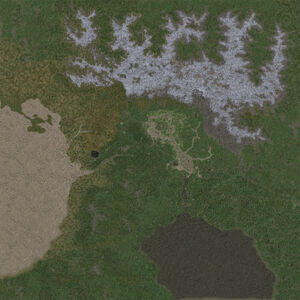
A colored map of Cyrodiil in 3E 433.
The central region of Cyrodiil, the Nibenay Valley, has for much of its history been a temperate region that supports the crops and livestock which feed the remainder of the province. This is enclosed by forests and broken by the rivers which feed the plain. The North and West gives way to mountains, while the south becomes more thickly forested as moves to the borders of Valenwood and Black Marsh. The Valus Mountains are an extension of the Velothi Mountains to the east. While there is a road network, much travel in the province has historically been by river.[2] Major cities in this area include the Imperial City itself, Bravil, Leyawiin, and Cheydinhal.
The Nibenay Valley is the most prominent area of the land, a great grassland with Lake Rumare in its heart. Several small islands dot the surface of this lake, and between them stand great bridges. It is on these islands that the Imperial City stands. The rest of Cyrodiil also contains the cities of Anvil, Bravil, Bruma, Chorrol, Cheydinhal, Kvatch, Leyawiin and Skingrad.
The west of Cyrodiil is named Colovia and includes the areas of the Gold Coast, the West Weald, the Colovian Highlands and the Imperial Reserve. This area includes the cities of Skingrad, Anvil, Chorrol and Kvatch. This area has rolling countryside and slopes down to a warm coastline to the West and rises to more rugged hills in the North. This area is also noted for its wealth and prosperity.
Cyrodiil as jungle[]
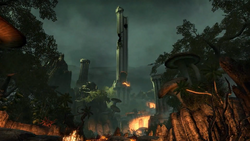
A vision of a jungled Cyrodiil, seen in the Sanctum Ophidia.
For parts of its history, Cyrodiil has been described as being primarily composed of jungle.[2][63] This has been noted by some as being a transcription error from ancient texts,[64] while others consider that a climatic change took place, either as a result of the actions of a person with CHIM[65] (most likely Tiber Septim)[66][UL 2] or through the White-Gold Tower adjusting the climate depending on who rules the land at a given time.[5]
Former Bethesda employee Michael Kirkbride has noted that Cyrodiil was originally going to be depicted in The Elder Scrolls IV: Oblivion as a jungle, but that this was changed during the game's development.
"Cyrodiil was going to be as described in the first PGE. [...] The heart of the province being what you think of when you think of a traditional jungle, tumbling down to the fields of large rice paddies that fed the Empire, guarded by Romanesque troops and dragons everywhere. The Imperial City was to be vast, rolling across wetlands and swamps, with large sections lost and overgrown, full of too many cults to count, the oldest temples having obviously been around since the Merethic."
He attributed the final appearance of the province to influence from The Lord of the Rings films that had been released around that time.[UL 3]
County capitals[]
Anvil[]
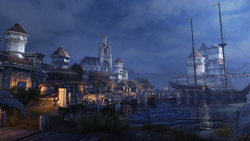
Anvil
- Main article: Anvil
The port of Anvil is the westernmost city in Cyrodiil, located along the Gold Coast. The Chapel of Dibella dominates its skyline. It is divided into five districts, including several markets and Castle Anvil, which lies outside the town walls.[67][68] Following a decree of the Elder Council in 3E 431, the Anvil Mages Guild is responsible for the sale of Restoration spells.[69]
Bravil[]
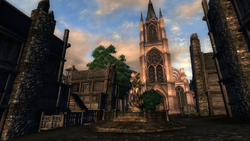
Bravil
- Main article: Bravil
Bravil is located in southern Cyrodiil on a small peninsula at the mouth of the Larsius River as it empties into Niben Bay. It has been thought to be one of the least well-off cities in Cyrodiil.[70] According to one legend, it is the place where Sithis and the Night Mother had the encounter which began the Dark Brotherhood.[71] In 4E 187, it was also the place of the private residence of the Dark Brotherhood's Listener, until the almost total destruction of the Brotherhood in Cyrodiil in 4E 200.[72][73]
Bruma[]
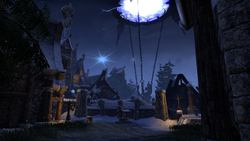
Bruma
- Main article: Bruma
Bruma is the northernmost city in the province of Cyrodiil, located in the Jerall Mountains along the border to Skyrim. Bruma's northern latitude, combined with its high altitude, results in poor soils and harsh weather.[33] The city is perpetually covered in snow, with clear, sunny days a rarity. The city, being heavily influenced by the Nords, has adapted to the climate with a much simpler, hardier way of life.[74]
Cheydinhal[]
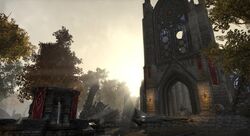
Cheydinhal
- Main article: Cheydinhal
Cheydinhal is the city closest to the Morrowind border near the Velothi Mountains. Being so close to Morrowind, Cheydinhal is populated and influenced considerably by the Dunmer.[75] To the north is Lake Arrius; to the south, the Reed River; to the southeast, Lake Poppad. The city serves as the centre for Alteration magic for the Cyrodiil Mages Guild.[69]
Chorrol[]
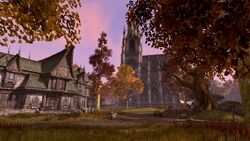
Chorrol
- Main article: Chorrol
Chorrol is a major city in Cyrodiil, located in the Great Forest, near the Hammerfell border. The city itself is heavily fortified as it serves as county seat for County Chorrol. Weynon Priory, a monastery of the Order of Talos, is located nearby. To the east is Castle Chorrol.
Imperial City[]
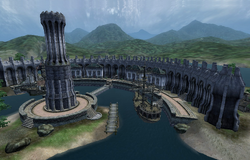
Imperial City
- Main article: Imperial City
The Imperial City, in the heartland of Tamriel, is the ancient seat of power and the capital of the Empire of Tamriel. It was once the center of an Ayleid city, noticeable in the gleaming white architecture and magnificent statues.
Kvatch[]
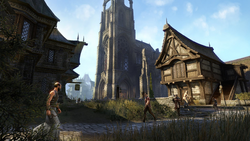
Kvatch
- Main article: Kvatch
Kvatch is a city located on the Gold Road between Anvil and Skingrad. The Count of Kvatch was Ormellius Goldwine, before being killed by the armies of Mehrunes Dagon, along with most of the citizens. The city was the site of the only Arena other than the one in the Imperial City. It is the location of one of the first Daedric incursions into Cyrodiil during the Oblivion Crisis.[76] Before its destruction, Kvatch was the second largest city in Cyrodiil, in front of Skingrad and behind the Imperial City. Kvatch was rebuilt by the time of the Great War.[60]
Leyawiin[]
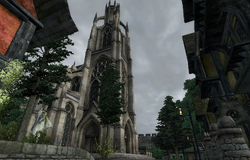
Leyawiin
- Main article: Leyawiin
Leyawiin is a fortified coastal city and capital of County Leyawiin, in the Blackwood region of southern Cyrodiil. County Lewayiin is nestled around the Southern Nibenay Basin, bordered by Black Marsh to the east, Elsweyr to the west, and the Topal Bay to the south. Situated on the southern west bank of the Lower Niben Bay, the city of Leyawiin guards the passage up the Niben River from Topal Bay to the Imperial City.
Skingrad[]
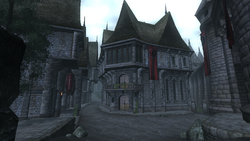
Skingrad
- Main article: Skingrad
Skingrad is a large city located southwest of the Imperial City on the Gold Road, near the border with Valenwood. Skingrad is noted for its wealth and this is reflected in the appearance of the city and its citizens. The city is divided into two sections: North and South. The North contains many upper-class homes, shops and the guild halls. The South is where the chapel is located and many other residences. It is separated by a huge trench running through the city. Before Kvatch was destroyed, Skingrad seemed to have been the third largest city in Cyrodiil. Now it seems to be the second largest city. Most of the city can be viewed from the bridge.
Economy[]
The economy of Cyrodiil is split between the different areas of the province. The center, focused around the Imperial City, is the wealthiest region, as it was here that merchants started to make their fortunes in the First Era. The west of Cyrodiil is very self-reliant, as reflected in the independent attitude of Chorrol and Colovia as a whole. Skingrad, Leyawiin and Anvil are some of the wealthier cities, whilst Bravil, in contrast, is the poorest.[28] The economy of Cyrodiil has been used as the model for economies throughout the rest of the Empire. Rice and textiles are its main exports, along with more esoteric treasure-goods, such as hide armor, moon sugar, and ancestor-silk.
Religion[]
Divines[]
The Nine Divines combines the syncretic Eight Divines pantheon with the founder of the Third Empire, Tiber Septim (Talos).[66] There are six gods and three goddesses, each of which technically forms their own cult of worship.[77] These cults are typically quite impersonal and the gods considered distant, although there are few exceptions, such as the cults of Akatosh, Dibella and Tiber Septim.[78]
There is a chapel in each major city in Cyrodiil, venerating one of the Divines. There are also wayshrines along the roads that are devoted to the Divines. These gods also tend to appear in various combinations in the pantheons of other cultures.[79][80]
Because Talos was not originally one of the Divines, in some religious sects they are referred to as "The Eight And One."[81] Following the signing of the White-Gold Concordat, Talos was effectively removed from the pantheon of the Gods and The Eight Divines worship resumed.[60]
The Cyrodilic Pantheon[]
In addition to the Divines, Cyrodiils also worship a range of heroes.[79] This is particularly common practice among the Nibenese, who are famed for their many small cults.[2]
Alessian Order[]
- Main article: Alessian Order
The Alessian Order was a once popular monotheistic religion created by the prophet Marukh in the early First Era. By the time of the Second Era, the religion had lost almost all of its followers.[2] The Alessians were often said to be very strict, humorless people,[82] with their reign over the Empire often remembered for its cruelty and follies,[83][36] and sometimes referred to as a 'dark age'.[78]
Daedra worship[]
Although technically legal, and referred to as the "acceptable blasphemies," at least at one point in Cyrodiil's history,[84] the practice of Daedra worship is frowned upon in Cyrodiil, meaning that those who do worship them tend to construct their shrines in remote places, away from major population centers.[85]
Culture[]
Education and wealth are broadly distributed across all social classes where Imperial culture has flourished. Many citizens are literate.[63] As the seat of the Empire, Cyrodiil has absorbed the cultures of many places on Tamriel, as well as taking onboard several Akaviri elements.[6]
Cyrodiil's own native culture is split between the Colovians and Nibenese. The former are pragmatic and hardy in outlook, while the latter foster asethetics and lean towards religious mysticism. The Nibenese typically form the ruling classes of Cyrodiil and the Imperial City, although the Imperial line itself has often been drawn from Colovia.[2]
Appearances[]
- The Elder Scrolls: Arena
- The Elder Scrolls II: Daggerfall (mentioned only)
- The Elder Scrolls Adventures: Redguard (mentioned only)
- The Elder Scrolls III: Morrowind (mentioned only)
- The Elder Scrolls III: Bloodmoon (mentioned only)
- The Elder Scrolls IV: Oblivion
- The Elder Scrolls V: Skyrim (mentioned only)
- The Elder Scrolls V: Dawnguard (mentioned only)
- The Elder Scrolls V: Dragonborn (mentioned only)
- The Elder Scrolls Online
References[]
- ↑ The Adabal-a
- ↑ 2.00 2.01 2.02 2.03 2.04 2.05 2.06 2.07 2.08 2.09 2.10 2.11 2.12 2.13 2.14 2.15 2.16 Pocket Guide to the Empire, First Edition: Cyrodiil - Imperial Geographic Society
- ↑ 2920, The Last Year of the First Era: Second Seed - Carlovac Townway
- ↑ Provinces of Tamriel
- ↑ 5.0 5.1 Subtropical Cyrodiil: A Speculation
- ↑ 6.0 6.1 6.2 6.3 6.4 6.5 6.6 Pocket Guide to the Empire, Third Edition: Cyrodiil - Imperial Geographic Society
- ↑ Loremaster's Archive – The Slave Rebellion
- ↑ The Wild Elves - Kier-Jo Chorvak
- ↑ 9.0 9.1 9.2 Daedra Worship: The Ayleids - Phrastus of Elinhir
- ↑ 10.0 10.1 10.2 10.3 The Last King of the Ayleids - Herminia Cinna
- ↑ Ayleid Survivals in Valenwood - Cuinur of Cloudrest
- ↑ Events of The Elder Scrolls Online
- ↑ Frontier, Conquest and Accommodation: A Social History of Cyrodiil - University of Gwylim Press
- ↑ Before the Ages of Man - Aicantar of Shimerene
- ↑ On Minotaurs
- ↑ 16.0 16.1 Father of the Niben
- ↑ 17.0 17.1 Brief History of the Empire, Book IV - Stronach k'Thojj III
- ↑ Minutes of the Elder Council
- ↑ The Warp in the West - Ulvius Tero
- ↑ 20.0 20.1 20.2 20.3 Brief History of the Empire, Book I - Stronach k'Thojj III
- ↑ Brief History of the Empire, Book III - Stronach k'Thojj III
- ↑ Assassination! - Black Horse Courier
- ↑ An Elder Scrolls Novel: Lord of Souls - Greg Keyes
- ↑ The Elder Scrolls IV: Oblivion - dialogue with Counts
- ↑ 25.0 25.1 Report: Disaster at Ionith - Lord Pottreid
- ↑ The Elder Scrolls III: Morrowind
- ↑ The Elder Scrolls V: Skyrim - Dialogue with Sybille Stentor
- ↑ 28.0 28.1 The Elder Scrolls IV: Oblivion
- ↑ Report: Quality of Recruits - Captain Lampronius
- ↑ Frontier, Conquest and Accommodation: A Social History of Cyrodiil - University of Gwylim Press
- ↑ Skyreach Explorer, Volume Four - Reginus Buca
- ↑ Before the Ages of Man - Aicantar of Shimerene
- ↑ 33.0 33.1 The Legendary Sancre Tor - Matera Chapel
- ↑ Trials of St. Alessia
- ↑ The Song of Pelinal, Book II
- ↑ 36.0 36.1 36.2 Shezarr and the Divines - Faustillus Junius
- ↑ Vindication for the Dragon Break - Fervidius Tharn
- ↑ Where Were You When the Dragon Broke?
- ↑ Pocket Guide to the Empire, Third Edition: Other Lands - Imperial Geographic Society
- ↑ Legacy of the Dragonguard - Kiasa-Veda
- ↑ Reman II: The Limits of Ambition - High King Emeric
- ↑ 2920, The Last Year of the First Era: Evening Star - Carlovac Townway
- ↑ History of the Fighters Guild
- ↑ Fighters Guild Charter
- ↑ The Brothers of Darkness - Pellarne Assi
- ↑ Pocket Guide to the Empire, Third Edition: Arena Supermundus - Imperial Geographic Society
- ↑ The Battle of Sancre Tor
- ↑ 48.0 48.1 The Arcturian Heresy
- ↑ The Wolf Queen, Book VI - Waughin Jarth
- ↑ The Wolf Queen, Book VII - Waughin Jarth
- ↑ The Wolf Queen, Book VIII - Waughin Jarth
- ↑ Biography of the Wolf Queen - Katar Eriphanes
- ↑ A Short Life of Uriel Septim VII - Rufus Hayn
- ↑ The Oblivion Crisis - Praxis Sarcorum
- ↑ Rising Threat, Vol. III - Lathenil of Sunhold
- ↑ History of Raven Rock, Vol. I - Lyrin Telleno
- ↑ Rising Threat, Vol. IV - Lathenil of Sunhold
- ↑ An Elder Scrolls Novel: The Infernal City, part two chapter one
- ↑ An Elder Scrolls Novel: The Infernal City, epilogue
- ↑ 60.0 60.1 60.2 60.3 The Great War - Justianus Quintius
- ↑ Cicero's Journal - Volume 2
- ↑ Cicero's Journal - Volume 4
- ↑ 63.0 63.1 The Elder Scrolls III: Morrowind – Savants' generic dialogue
- ↑ The Heartland of Cyrodiil – Phrastus of Elinhir
- ↑ Commentaries on the Mysterium Xarxes, Book 3 – Mankar Camoran
- ↑ 66.0 66.1 The Elder Scrolls V: Skyrim – Heimskr's Sermon
- ↑ Guide to Anvil - Alessia Ottus
- ↑ Gold Coast Guide, Part Two - Astinia Isauricus
- ↑ 69.0 69.1 Mages Guild Charter
- ↑ Guide to Bravil - Alessia Ottus
- ↑ The Night Mother's Truth - Gaston Bellefort
- ↑ Cicero's Journal: Volume I
- ↑ Cicero's Journal, Volume IV
- ↑ Guide to Bruma - Alessia Ottus
- ↑ Guide To Cheydinhal - Alessia Ottus
- ↑ Events of The Elder Scrolls IV: Oblivion
- ↑ For my Gods and Emperor - Imperial Cult
- ↑ 78.0 78.1 Reflections on Cult Worship - Cuseius Plecia
- ↑ 79.0 79.1 Varieties of Faith in the Empire - Brother Mikhael Karkuxor
- ↑ The Monomyth
- ↑ The Elder Scrolls IV: Knights of the Nine - Dialogue with The Prophet
- ↑ Rislav the Righteous - Sinjin
- ↑ The Final Lesson - Aegrothius Goth
- ↑ Pocket Guide to the Empire, First Edition: Invocation - Imperial Geographic Society
- ↑ Modern Heretics - Haderus of Gottlesfont
| Provinces | |
|---|---|
| Tamriel | |
| Akavir | |
